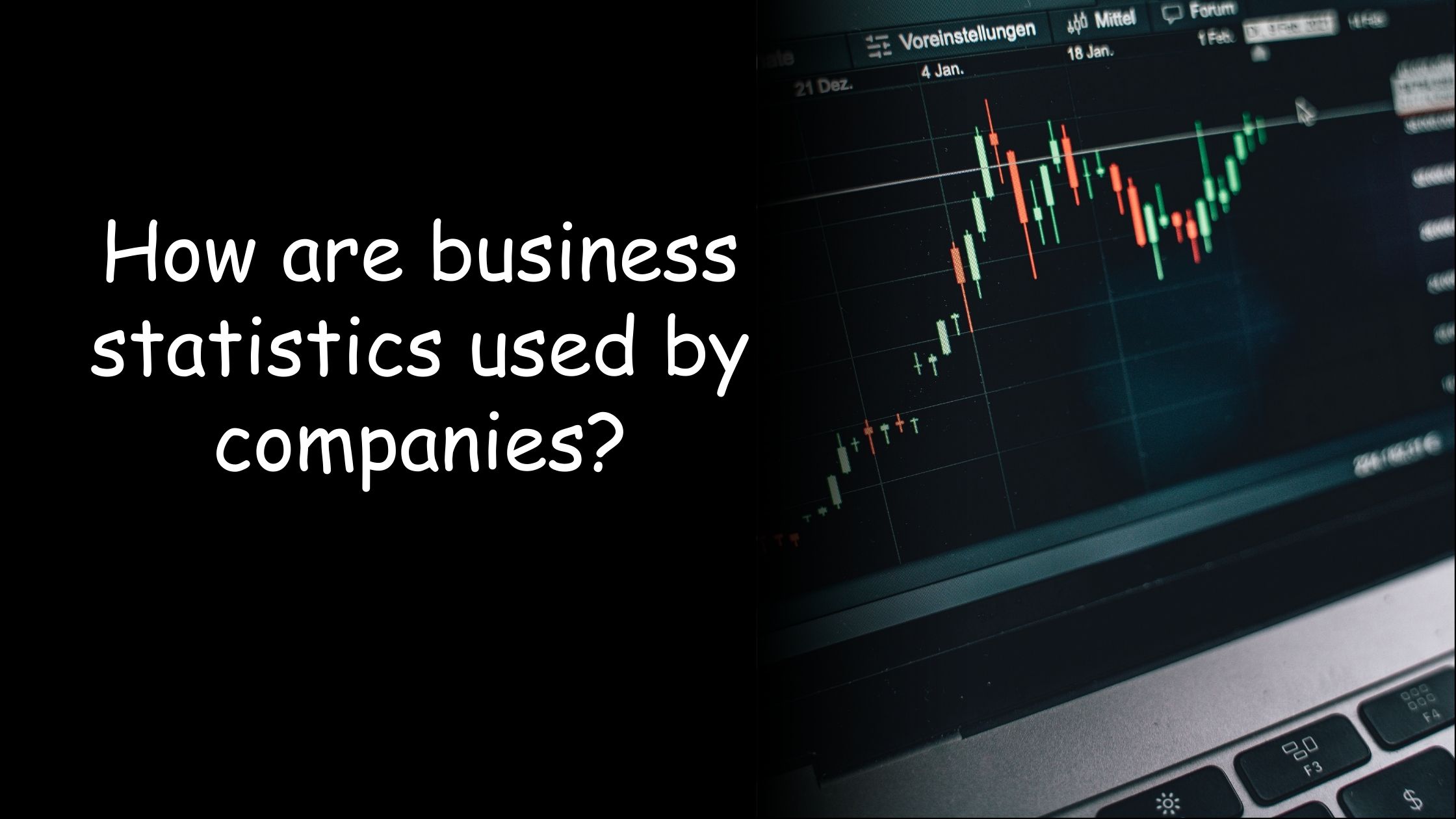How are business statistics used by companies?

Business statistics is the extraction of useful information that is contained in data available to a business, and it will use different ways of presentation of various statistical methods and concepts so that understanding provided enables effective decision-making. Mastering statistics can have a big impact on your career if you’re a math student majoring in statistics and feeling overwhelmed by the workload to the point where you’re thinking to avail “take my online stats class for me” service.
As we have said above that beyond merely being a subject, business statistic is a tool that helps companies analyze data and decide how to proceed. Students who feel overwhelmed by the task given by teachers in college and school, they often think about pay someone to do my online class service so that they can save some time for extra studies and prepare for examinations.
See also: Broad Overview to a Career as a Chartered Accountant
Why Is Business Statistics Important?
It allows a business to understand trends in their operations. To accomplish this, business statistics may be applied.
- A business can forecast amounts of sales using past patterns of trends in the information relevant to its sales transactions.
- It can be used to determine whether the business proposition of the company is feasible or not
- This influences the overall success of the company. The companies can also establish the fact of whether a particular marketing campaign has, in reality, helped them in acquiring new customers or not.
- This will help them to plan the future move in a much better way. Business analytics rely on business statistics.
- The organization must know productivity strengths and weaknesses at current status before they could develop some plans to optimize the effectiveness of a team.
- They can get it through the information they have generated in some previously done projects.
However, only information gathering will not provide any recommendations to management to the issue of enhancement of performance. In this case, the importance will be given to business statistics.
What Are the Different Business Statistics Types?
There are two categories of business statistics. Differential statistics is the first type of statistics and is mostly used to track changes and trends across time. Conversely, inferential statistics are a useful method for making inferences about the whole community from the analysis of a lesser number of participants
Differential statistics
Through the application of this method, considerable data is meaningfully and practically summarized into discrete pieces of data. Tables, charts, and graphs are just a few of the statistical instruments that it utilizes to illustrate specific phenomena and draw conclusions.
This approach investigates what transpired and explains the cause. Managers can review prior mistakes and accomplishments by using historical data. Descriptive statistics are frequently used in financial services, marketing, and logistics.
Inferential Statistics
Businesses take samples from a broader audience to investigate the features of that population using inferential statistics in business statistics. This method helps specialists in developing a comprehensive grasp of the population under investigation.
By looking at the information gathered from the sample, businesses can use this kind of analysis to determine the characteristics of a population. They are nevertheless able to draw broad conclusions from a tiny sample.
Data professionals use a variety of techniques, including group sampling, sampling by chance, stratification, and systematic sampling, to guarantee data accuracy. It is now quite conceivable to ensure that the samples obtained are indeed representative of the population under study using these methods.
In what forms do firms use business statistics?
Businesses turn to business statistics in numerous ways to achieve improvements in overall efficiency, predicting developments, consumer habits, process optimization, and influencing the correct decisions. In what follows, a summary of some important topics is presented.
Manages Financial data
Sound finances are a must for any business to survive. Without strong financials, its expansion is also impossible. Book-keeping and Finances are the two major related financial functions of an organization. These facilitate organizing and properly channelizing the funds by the business. To guarantee long-term prosperity and financial security, however, these are insufficient.
Every company produces enormous amounts of data in the course of their regular business. Making intelligent use of this information can provide a wealth of knowledge about effective money management. This is where business statistics come into play.
Recognizing Trends
It is very important for the companies to understand the market conditions for deciding what type of improvements or changes in their product or marketing plans they need to make. This information can be garnered only from the outside. One method to understand the trending analysis and latest trend is business statistics.
Also, the analysis of market data helps in predicting future developments; it makes it easier to generate company concepts at a high level and enables one to rise at the top of the field. Additionally, organizations can receive early alerts regarding any risks present in the market.
Human Resources
Deciding who to hire by using data-driven evaluations of applicants. They also assess worker’s performance and pinpointing areas in need of development and improvement. By using statistical analysis to manage diversity and acceptance in the workforce.
Evaluation of Value
Value appraisal becomes significant for those businesses that want to invest money into a property i.e. real estate and even financial corporations that think of lending money for constructions or automobiles. Both these need to have an accurate value assessment of the property in question. Business statistics can also be used for the same purpose.
The value of the property, over which banks are planning to loan funds, must be known. The bank is required to seize and sell the property if the borrower defaults on the loan.
Limitations of statistical business information
Business statistics have their limits despite being informative. To utilize statistics in corporate decision-making with confidence and knowledge, it is critical to understand these limits as well. If students use take my online stats class for me service, they need to understand that learning deep about business stats is important because it will be very helpful in their career choices also.
The following are some restrictions on company statistics:
- Data Quality: The caliber of the data gathered has a major impact on how accurate statistics are. Concluding anything incorrectly can result from insufficient or inaccurate data.
- Interpretation Difficulties: It’s possible that statistics don’t always make sense. Making incorrect choices might arise from misinterpreting or misinterpreting the data.
- Absence of Context: Some data points are not included in their context or the larger picture. It is simple to make inaccurate or deceptive judgments when one does not have a thorough awareness of the larger context.
- Criterion Relying: A lot of statistical techniques rely on particular information distribution assumptions. The statistical results could not be trustworthy if these presumptions are false.
The Range of Business Statistics Careers
Now, let’s examine the several positions and duties that are frequently found in the field of business statistics.
Data Analyst:
Gathering, organizing, and analyzing data in order to draw conclusions is the responsibility of data analysts. They use a variety of software programs to evaluate knowledge and successfully convey their conclusions.
Analytical Specialist:
Statistical consultants provide their knowledge of statistical techniques and data analysis to various firms in order to address certain business issues.
Actuary:
Actuaries apply statistical techniques in the assessment of risks involving finances. They majorly work for pension plans and insurance firms where they are involved in determining future liability estimates and setting premium rates.
Market research analysts:
It collects and analyzes data to know consumer tastes, economic conditions and rivalry, therefore aiding firms to make well-informed decisions.
Operations research analysts:
These professionals apply mathematics and statistics to help an organization tune its cumbersome processes and improve productivity and the decision-making process
Business Intelligence Analyst:
Company intelligence analysts present tables, graphs, and other representations that distill information into meaningful conclusions to assist strategic decision-making.
Conclusion
No business organization can ever be successful in this fiercely competitive business environment without access to U.S. business statistics. Risk management, well-informed decision-making, assurance of quality, and market research inclusive are the many uses of business statistics. However, for an organization to get to the very core of business statistics, it has to implement the right technology and ensure that data quality is up to the standard, as well as train personnel accordingly.
Whether you’re thinking about hiring someone to complete your online course or you just want to improve your grasp of business statistics, knowing this subject is the key to success in the information-rich economy of today.




